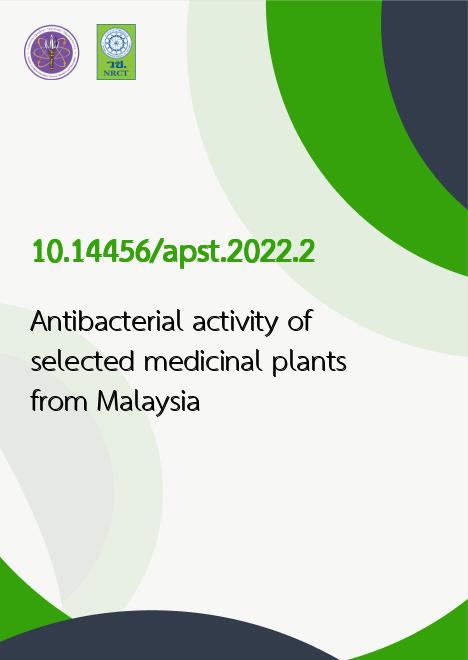
|
Antibacterial activity of selected medicinal plants from Malaysia |
|---|---|
| รหัสดีโอไอ | |
| Creator | Nam W. Sit |
| Title | Antibacterial activity of selected medicinal plants from Malaysia |
| Contributor | Sze M. Chan, Voon Y. Fong, Seng Y. Koo, Tansra R. Singh, Esther H. Tang, Lit T. Thoo |
| Publisher | Asia-Pacific Journal of Science and Technology |
| Publication Year | 2565 |
| Journal Title | Asia-Pacific Journal of Science and Technology |
| Journal Vol. | 27 |
| Journal No. | 1 |
| Page no. | 10-Jan |
| Keyword | Minimum inhibitory concentration, Minimum bactericidal concentration, Abelmoschus esculentus, Basella alba, Citrus microcarpa, Clerodendrum calamitosum, Nasturtium officinale, Parkia speciosa |
| URL Website | https://www.tci-thaijo.org/index.php/APST |
| Website title | https://so01.tci-thaijo.org/index.php/APST/article/view/245003 |
| ISSN | 2539-6293 |
| Abstract | Natural sources such as medicinal plants are potential sources of new antibacterial agents to overcome drug resistance and adverse effects. This study aims to investigate the fruit of Abelmoschus esculentus (Malvaceae; okra), the aerial parts of Basella alba (Basellaceae; Malabar spinach) and Nasturtium officinale (Brassicaceae; watercress), the leaves of Citrus microcarpa (Rutaceae; calamansi) and Clerodendrum calamitosum (Lamiaceae; white butterfly bush), and the seeds and pods of Parkia speciosa (Leguminosae; stink bean) for antibacterial activity. To obtain a wide polarity range of secondary metabolites, the plant materials were extracted sequentially using six solvents of increasing polarity. Each plant extract was evaluated against five species of human pathogenic bacteria. The results showed that all six medicinal plants possessed antibacterial activity but with different degrees of bacteriostatic and bactericidal activities. Among the 42 extracts, 76.2% of them showed bacteriostatic activity while only 20 extracts (47.6%) exhibited bactericidal activity. The strongest bacteriostatic activity was shown by the hexane and chloroform extracts of N. officinale against Pseudomonas aeruginosa with a minimum inhibitory concentration value of 0.02 mg/mL. The highest total activity was given by the hexane extract of C. microcarpa against Bacillus cereus (56.84 mL/g). For P. speciosa, all six extracts from the pods showed bacteriostatic activity while only the hexane and ethanol extracts from the seeds were active against the bacteria. The extracts of B. alba and N. officinale warrant further isolation and identification of bioactive compounds as they exhibited the broadest bactericidal activity (minimum bactericidal concentration: 0.02-2.50 mg/mL) against all bacterial species. |